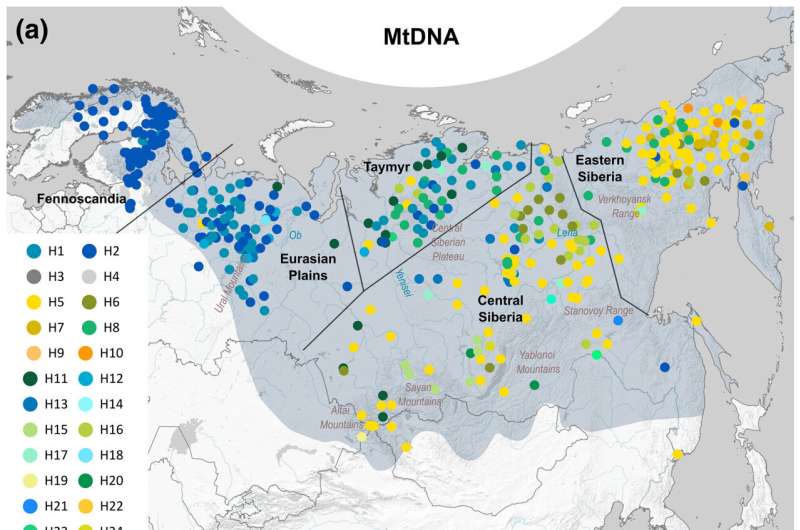This article has been reviewed according to Science X's editorial process and policies. Editors have highlighted the following attributes while ensuring the content's credibility:
fact-checked
peer-reviewed publication
trusted source
proofread
Nordic wolverines have the worst genetic diversity status, comprehensive Eurasian-wide study shows

The Fennoscandian wolverines have the lowest genetic diversity out of all the wolverine populations in the vast Eurasian continent. The new study covers the Eurasian range of the wolverine, which has not been studied on such a large scale before. Samples were collected across a wide geographical area from Norway to eastern Russia.
The study, led by the University of Oulu, Finland, reveals significant insights into wolverine (Gulo gulo) population structure, genetic diversity, and demographic history across the Eurasian range. The study identified a distinct substructure within the wolverine populations, with the most distinct group found in Fennoscandia. This particular population has also experienced a genetic bottleneck during the 20th century. The research is published in the journal Diversity and Distributions.
Genetic diversity is important as it helps species adapt to environmental changes such as climate change, which is rapid in the north. Isolated populations with low genetic diversity can suffer from inbreeding, increased mutational load, and negative fitness effects.
"Now we know the distribution of genetic diversity of the Eurasian wolverine. We know where it is the most diverse and where the least, which populations are well-connected, and which need reconnecting. The results of our study help us to specify how we should invest the management strategies in Fennoscandia," concludes Dominika Bujnakova, a Doctoral Researcher at the University of Oulu.
"Such extensive data on Eurasian wolverines has not been studied before. Unfortunately, the data shows that the genetic status of wolverines in the Nordic countries is the worst," says Senior Research Fellow Laura Kvist.
"The new study is significant because of its wide geographical coverage, as usually studies focus on smaller areas. It is now possible to compare the situation of wolverines in different regions, which underlines the importance of geographically broad studies."
The researchers' extensive collaboration included a variety of museum sample materials from 1830–2021, including bones, teeth, pelt, hair, and muscle tissue. Scat samples were collected from the wild, for example in eastern Russia.
Living in northern Eurasia and North America, the wolverine is adapted to the cold and plays an important role in its ecosystem as a predator and scavenger. In Finland, the wolverine is an endangered species. There are roughly 450 wolverines in Finland while in Scandinavia there is about 1000 individuals. The wolverine is one of Finland's large carnivores, and it also causes heated debates and conflicts with farmers and reindeer herders.
Previously, clear genetic differences have been found in Finnish wolverine populations between northern (fell) wolverines and eastern Finnish (forest) wolverines.
New findings further emphasize the need for enhanced connectivity between the Fennoscandian wolverines and other Eurasian populations to ensure gene flow and the species' long-term survival. For example, conservation corridors may mitigate the negative effects of habitat fragmentation, and human-carnivore conflicts should also be mitigated. In addition to the Nordic countries, the study provides evidence on the current status of wolverine populations for management authorities across Eurasia.
The study is beneficial as a reference for studies on other species and showcases the importance of global scientific cooperation in wildlife conservation. The research was the result of an international collaboration led by the University of Oulu with researchers from universities and research institutions from Denmark and Russia.
More information: Dominika Bujnáková et al, Expanding from local to continental scale—A genetic assessment of the Eurasian wolverine, Diversity and Distributions (2024). DOI: 10.1111/ddi.13846
Journal information: Diversity and Distributions
Provided by University of Oulu


















